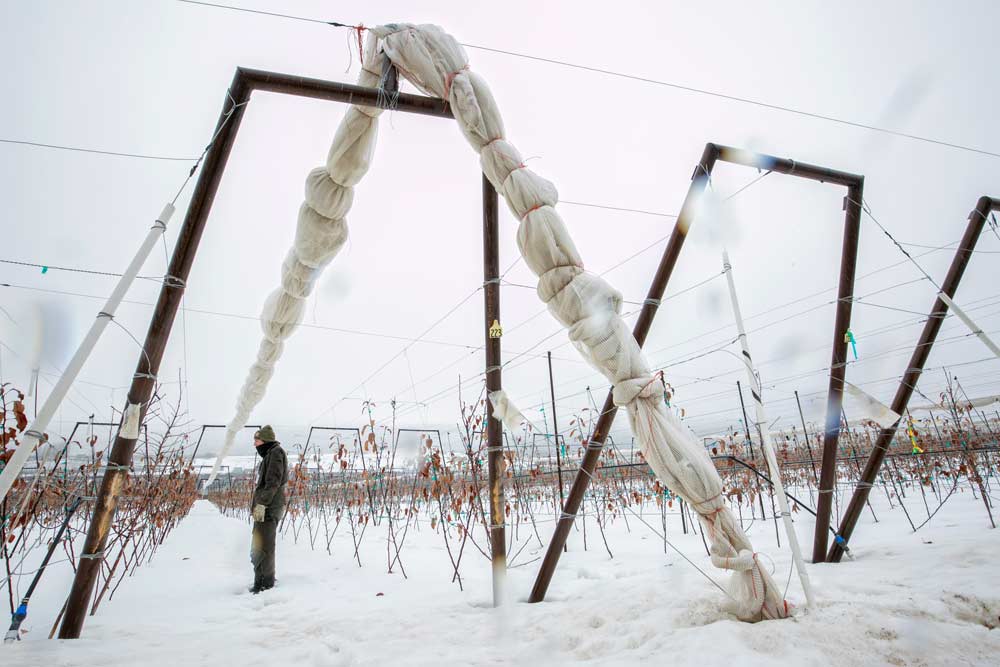
Nova Scotia grower Andrew Stirling stands in the rain beneath Auvil Fruit Co.’s four-wire training system during a stop at Auvil Fruit’s Orondo, Washington, orchard during the International Fruit Tree Association’s 60th annual conference in February. Auvil’s Del Feigal says he expects to produce 100 bins per acre on this Gala block.
(TJ Mullinax/Good Fruit Grower)
Auvil Fruit Co., long an innovator among Northwest tree fruit growers, had a new surprise for growers attending the International Fruit Tree Association’s 60th annual conference in Washington in February: bloom thinning by hand.
Auvil handles almost all of its thinning on color varieties by hand; the only variety still chemically thinned is Granny Smith, according to Del Feigal, the company’s president of orchard management.
While labor intensive, Feigal said, the move enables him to ensure the orchard sets just the right crop, with apples in the correct locations on the tree.
“We’ll have an idea for that variety, for that situation, how many apples we want on that particular tree, based on past experience, to achieve our goals on size, sugar content, on all of those things,” he said. “We’ll end up leaving that many flowers in those positions at that particular time. Then we’ll come back in the summertime if we left a little bit too many, and we’ll green fruit it down to the numbers we want.”
Thinning starts at pruning time to try to thin down the crop, with an idea about how many buds should remain — and where — on each tree. That then allows blossom thinners to do their work.
Feigal said they don’t usually leave king bloom, because it never has shown a positive increase in fruit quality.
For some varieties, such as Fuji or Pink Lady, king bloom will enable a bigger apple, but sometimes growers don’t want bigger apples, Feigal said.
“For Galas, it doesn’t give you a bigger apple for side bloom versus king bloom, when you’re utilizing thinning by hand, there’s no difference,” he said. “Side bloom catches up, and it tends to be as aggressive as a king bloom.”
Thinning the king bloom costs more, because it’s a two-hand move, increases costs almost 30 percent, he said.
And in Honeycrisp, leaving the king bloom when blossom thinning by hand ultimately increases the seed count per apple, which also can cause the alternate bearing issues seen in that variety.
Generally, Feigal said the company hand thins Fuji and Honeycrisp for return bloom, Gala to increase size, in the average 80 to 72 count, and Pink Lady to reduce fire blight risk.
“The less flowers out there, less chance for fire blight infections, especially if you’re going through thinning down to your primary bloom and pinching out your late blooms, so it’s not there for two to three weeks after petal fall,” he said. “It almost cuts your time for fire blight in half and worry about cover sprays.”
For Granny Smith, hand thinning appears to create unwanted bigger fruit, so Auvil still thins the variety chemically.
Labor costs

Del Feigal speaks to International Fruit Tree Association attendees at Auvil Fruit’s Orondo, Washington, orchard in February. (TJ Mullinax/Good Fruit Grower)
Feigal acknowledges the process takes a lot of people; he figures he needs one person per acre for the season, so if he wants to thin every spur on 100 acres, he needs 100 people to do that.
The best time to start plucking flowers, with no pruners required, is when the flower just pops out. The workers who know the routine won’t cut their fingernails for several weeks prior to blossom thinning, which is their little trick to make the task easier, he said.
“In certain varieties, like Honeycrisp and Fuji, we already know how many apples we want per limb. It varies, depending on our plantings, from two apples per limb up to four,” he said.
Then, as the blossom thinners start their work, the instructions will be to delete four flowers on that particular limb in the best position. An added bonus to that: if there is a bad return bloom, with only two clusters, the thinners can leave two doubles and still leave four flowers, he said. Any extras can be taken off.
“Hopefully you don’t have more than eight clusters, because the pruners weren’t doing their job then,” he said with a laugh.
For some varieties, such as Pink Lady, because it’s one of the first to bloom, Feigal also said he’ll thin primary bloom, then do a fast pass to get rid of rattail bloom to ease fire blight concerns.
Trellis ease
In some blocks, Auvil is also moving to a shorter, four-wire trellis system with 8-foot rows, with anywhere from 1,600 to 2,400 trees per acre. The system replaces the company’s traditional eight-wire trellis with 12-foot rows.
The top wire in the new system is 6 feet, 6 inches in height, compared with 13-foot heights for the top wire in the traditional system.
One advantage, Feigal said, is the new system requires less equipment and fewer ladders and people — including for labor-intensive blossom thinning. In addition, the company is able to get the shorter system into production sooner, with plantings from rootstock and from bench grafts, his preferred method.
“It has a lot to do with varieties, but I’m hoping the four-wire will produce the same tonnage as the 12-foot system,” he said. “But we’ve already learned it’s not good for Grannys, which we still plant on 12-foot rows.” •
– by Shannon Dininny






Leave A Comment